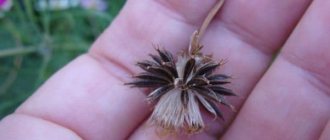Cosmea, aka “Mexican aster”, “beauty”, “space”. It is a green herbaceous plant with dazzling petals. Belongs to the Asteraceae or Asteraceae family. It was first discovered in South and Central America. If you translate the name from Greek, you get the word “decoration”. Today it is popular all over the world for its unpretentiousness and decorativeness. Because it is easy to watch, it is perfect for beginners.
Types and varieties of cosmos
There are more than 20 specimens of the plant, let's look at the most common ones.
Double-pinnate
The most famous annual herbal plant, with roots from Mexico, up to 1.5 m high. Its leaves are divided into thread-like lobes, reminiscent of dill foliage. The diameter of the inflorescence is approximately 7-10 cm. The baskets come in pink, white, purple, and red colors. The following varieties are distinguished:
| Variety | Description |
| Low growing varieties | Sonata Series. The color of the flowers is pink with a red areola in the middle. |
| Dazzler | Raspberry-colored petals. |
| Purity | With white baskets and elastic stems. |
Sulfur yellow
Grows in the vicinity of Latin America. It is considered an annual plant and loves warmth. The baskets are orange or yellow-golden in color.
| Variety | Description |
| Diablo | Fiery red. |
| Bilbo | Orange. |
| Crest Lemon | Lemon yellow. |
Chocolate
Another name for it is blood red or black. It is a perennial plant. The flowers are burgundy in color and smell like chocolate. Loves warmth and is mostly kept in pots.
However, you can also grow it in open ground, and when the cold comes, cover it or move it indoors.
Terry species are in great demand.
The most famous varieties:
| Variety | Description |
| Antiquity | At first the baskets are a rich ruby red color, and then change to a coral golden brown. |
| Double click rose bon-bon | Pink. May not resume growth for a long time after circumcision. |
| Brightness | It is characterized by pomp and richness. |
Terry
The petals are arranged in several rows, which gives them splendor and special beauty. May be sunny yellow, burgundy or orange.
How to sow: step-by-step instructions
Sowing is carried out in several stages:
- Soil preparation. Cosmea prefers loose, light soil. Any ready-made mixture from the store or a self-prepared substrate of fertile soil and sand in equal quantities is suitable. For nutritional value, a little humus or compost is often added.
- Soil treatment. Self-prepared soil must be disinfected in a steam bath or in the oven for 30 minutes.
- Seed disinfection. A weakly concentrated solution of potassium permanganate is suitable for disinfection.
- Distribution of seeds into pots. Seedling containers are filled with prepared soil and the surface is compacted. The seeds are lightly pressed into the soil. There is no need to sprinkle them as they need light to germinate.
- Creation of greenhouse conditions. After distributing the seeds, the soil is moistened with a spray bottle. The containers are covered with glass or film and placed in the brightest possible place. The optimal temperature for germination of cosmos seeds is from 15 to 18 °C.
Cosmos seeds have good germination, so stratification, i.e. imitation of the influence of natural winter conditions, is not required before sowing.
Stratification is not required for cosmos seeds; on the contrary, they need to create greenhouse conditions and ensure a constant supply of sunlight
Varietal mixtures
These are varieties that include flowers of the same type, but differ in color.
Sensation
A mixture of cosmos, reaching a height of 1-1.5 m, baskets of white, pink and red shades.
Rainbow tints
It pleases the eye with its harmonious variety of tones; there are pink, red, white, brown-crimson. Grows up to 1.2 m.
Sea shells
The most interesting species is characterized by reed inflorescences connected into a tube, branching and similar in appearance to shells.
Application
If we talk about the use of the plant in various spheres of life, then in this case scientists have not yet sufficiently studied all the properties of cosmos.
At home
In everyday life, cosmos can only be used as decoration for a home or garden plot. This is a very good solution, since cosmos is not picky and does not require special care or constant watering. Well, of course, it has a very beautiful appearance, which allows it to become the center of attention of your flowerbed.
Growing cosmos
A popular method of propagating it is by seed. For this reason, in temperate climates the perennial is grown as an annual plant. There are two growing methods: seedlings and seeds.
- In the first method, to obtain young plants, seeds are planted in small boxes with soil (preferably a sand-peat mixture) in early spring, lightly pressed into the ground and placed in a sunny room at a temperature of +18...+20 °C. The appearance of sprouts is expected after 7-14 days. Once they reach a certain size, they are transplanted into a larger tank, maintaining intervals of 10-15 cm. Then the temperature regime should be changed to +16...+18 °C. The first flowers are expected in early June.
- The second method is to place the seeds in the ground outside. First, dig a small hole 10 mm deep (after the snow has melted). Then the seedlings are dispersed in 3-4 pieces, keeping a distance of 30-40 cm between them and watered so that the seeds are not washed out. Subsequently, they are cared for like adult plants. Flowering is observed at the end of July.
Sowing time
The timing of sowing cosmos depends on many factors: the climate of a particular region, soil fertility, method of cultivation, etc.
By region
Cosmos seedlings at the age of 2–2.5 months have the best survival rate. Therefore, the timing of its sowing with a focus on the onset of heat in the regions is as follows:
- Southern regions - from the end of January to the first ten days of February.
- The middle zone is from mid-February to early March.
- Siberia, Ural, Leningrad region - from mid-March to early April.
Cosmea gives abundant self-seeding: once it appears on the site, it will remain there forever
According to the lunar calendar 2022
The most favorable dates for sowing cosmos according to the lunar calendar of 2022:
- February - 20–28;
- March - 1, 3–4, 20–23, 28–30;
- April - 1, from 18–21, 24, 25–26, 29.
Unfavorable days are March 3, 5 and 31, April 5.
Planting cosmos in open ground
Planted in late May or early June, when light morning frosts are already behind us. Choose a place that is windless and sunny. The land is pre-prepared: it should not be very nutritious, the pH level should be in the range of 5.1-5.5, well drained. When the height of the seedlings is 60 mm, they are placed in dug holes 30x30 cm in size, filled with water. Next, they are covered with soil and watered again.
For tall plants, sticks are stuck nearby so that later, if necessary, you can tie it up. When the bush reaches 50 cm in height, pinch off the tops of the stems. Thanks to this, the cosmos will grow fluffy and graceful.
Secrets of success
Cosmea develops best in well-lit areas, but can also grow in light partial shade. With a clear lack of sunlight, the bush becomes elongated and blooms weakly.
It is important to choose a location protected from winds to prevent the fragile stems from breaking. Additional insurance, especially for tall varieties, will be the installation of supports.
IN THE PHOTO: Cosmea feels quite comfortable in any soil. However, the more nutritious the soil, the more actively the foliage grows, and flowering begins much later and becomes scarce. Photo by: @weloveourgarden.
The plant needs abundant watering only at the very beginning of the growing season. Then it is enough to carry out the procedure once a week. Loosening the soil after watering, as well as killing weeds, are mandatory maintenance requirements.
The bushes are fed with complex mineral fertilizers after planting seedlings or thinning seedlings, in the budding phase and at the beginning of flowering.
Pinching stimulates lateral branching, removing faded heads stimulates the formation of new buds. A heavily overgrown bush can be trimmed to give it any shape. It is noteworthy that after cutting, flowering does not deteriorate.
Diseases, pests
It is not susceptible to diseases and pests, however, it may be subject to their attacks at the initial stage of growth. If snails and slugs are found on the leaves of a flower, they are collected by hand and destroyed. A good option would be to install a trap with beer, which will significantly reduce the number of parasites; you just need to check them regularly and replace the bait.
Description of the plant
The plant belongs to the Asteraceae (otherwise known as Compositae) family; the genus includes more than 20 species of flowers .
The natural habitat of cosmos is in the subtropical and tropical zones of South America; it can be found much less often in North America, while most of the plants are found in Mexico, its mountainous part.
Depending on the variety, the size of a well-branched bush can vary from half a meter to one and a half meters in height.
Thin flexible shoots of cosmos are vertically oriented. The leaf blades are oppositely located, doubly dissected, very beautiful.
The period when cosmos blooms is long, it can last for three months: it begins in July and ends with the first autumn cold snap.
The inflorescences- baskets of cosmos resemble large daisies in appearance (the diameter of a fully open calyx can reach 12 cm).
The corollas can be either single or part of loose paniculate inflorescences.
The most common color of the petals:
- pink;
- white;
- orange;
- purple;
- red;
- golden yellow.
Mr. Summer Resident informs: the reasons why cosmos does not bloom
The following can be distinguished:
- Late landing. If you do not do this on time, the flower may not have time to open.
- Excessive feeding of the plant. Due to the fact that the land in which the flower grows is excessively fertile, all its forces go towards increasing the green mass: tall and thick stems, large leaves. To avoid this, you should control the time and amount of fertilizer applied.
- Violation of the rules of care (overwatering, placement in the shade) can lead to poor flower opening.
Rules of care
Cosmea is light-loving, so seedlings are kept on a southern or southwestern windowsill. Due to lack of lighting, plants will become stretched and weakened. When planting early, they need additional lighting.
In the winter season, cosmos seedlings require additional light; special lamps for plants will be an excellent solution
Water the seedlings moderately with warm, settled water. At the age of 15–20 days, plants are fed with complex fertilizer for ornamental crops. A single feeding for the entire period of growing seedlings is sufficient.
15–20 days before planting in a permanent place, seedlings begin to be hardened on the balcony or street. On the first day, the duration of the “walk” should not exceed 20–30 minutes. Then the time spent in the fresh air is gradually increased.
Disembarkation procedure
To plant seedlings at the beginning of summer, it is necessary to prepare holes for flowers. If you have chosen a tall variety, then their dimensions should be 35 x 35; for lower varieties, 30 x 30 will be enough. Before planting the seedlings, the holes should be watered. After this, you can place the seedlings in the holes, dig them in and water them again.
It should be taken into account that tall varieties need supports, which need to be installed while the seedlings are still small. Buried rods or slats are suitable for this. When you see that the cosmos has reached a height of 50 centimeters, you can pinch it. This will allow the plant to bush better. Cosmea, which was grown from seedlings, will delight you with the first flowers closer to mid-July.
Collecting seeds
If you have perennial cosmos in your garden bed, then it is better to propagate it by cuttings or tubers, but annual cosmos propagates exclusively by seeds. Moreover, it is not at all necessary to collect seeds every summer and ask the question: when to plant cosmos? Growing from seeds can take place without your participation, since this plant can reproduce by self-sowing. But not constantly, but only for several years.
But if you do not trust this method of planting, then outline in advance several flowers from which you will then collect planting material. There is a risk that ripe seeds will fall to the ground. To prevent this, you should put gauze bags on the heads. Darkened seeds can be safely collected. Please note that collected seeds will not retain varietal characteristics. This is due to the fact that cosmos is a cross-pollinated plant. Therefore, experienced gardeners recommend purchasing planting material annually from specialized stores. Moreover, you should choose seeds from those companies that have already proven themselves to be good.











